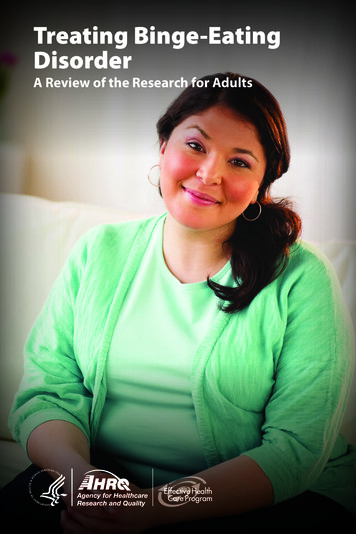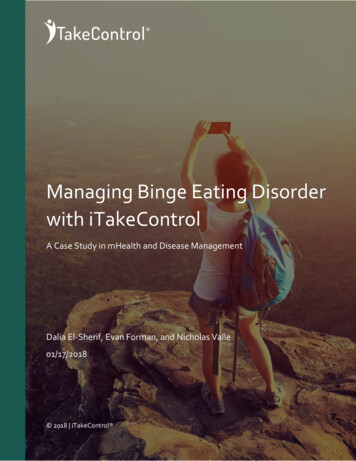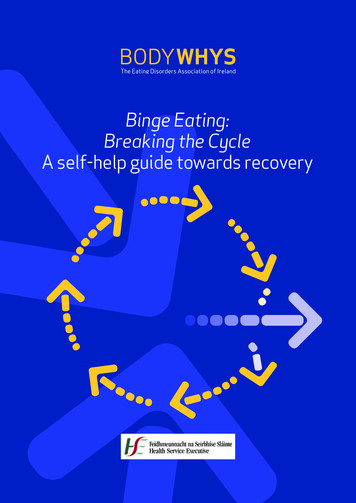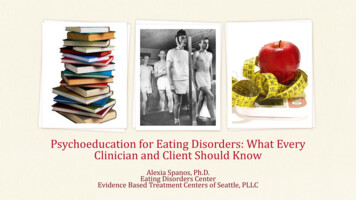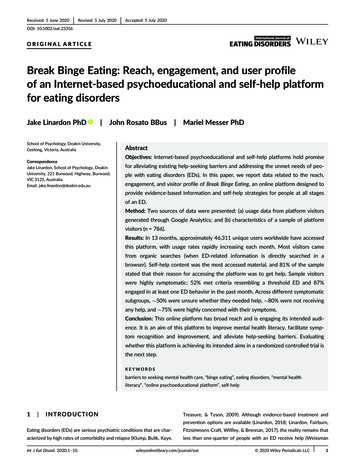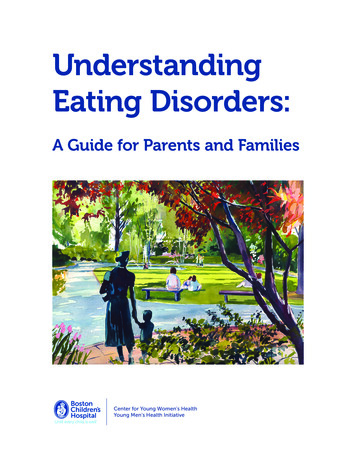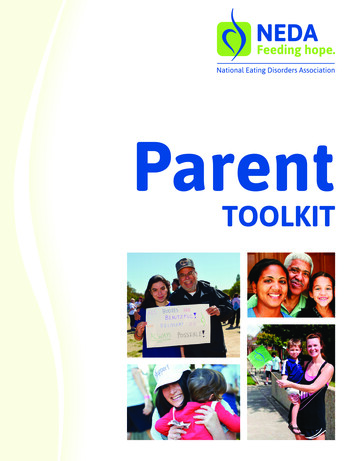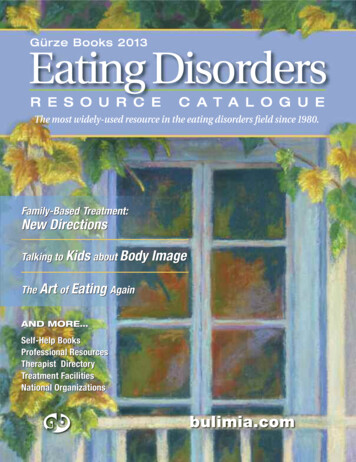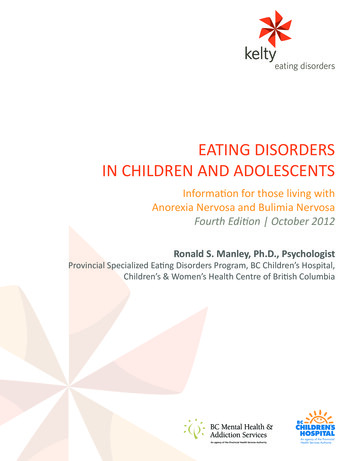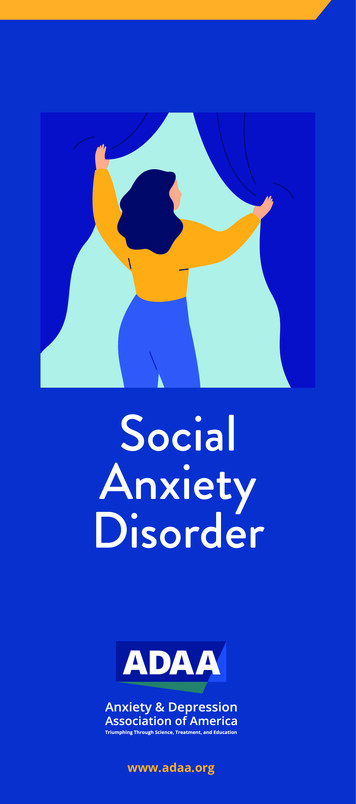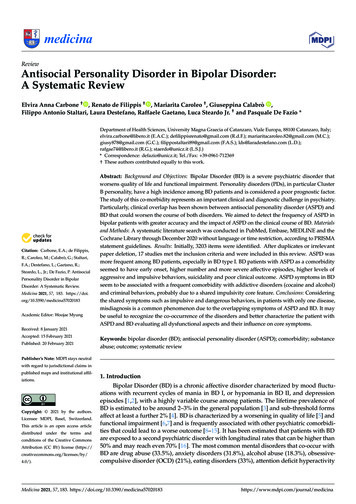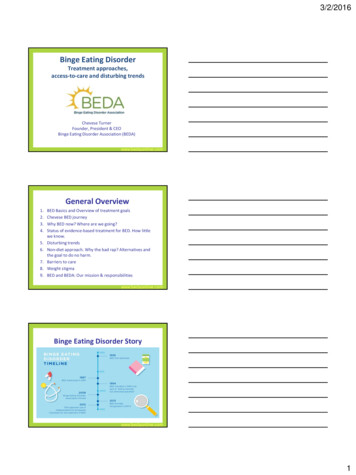
Transcription
3/2/2016Binge Eating DisorderTreatment approaches,access-to-care and disturbing trendsChevese TurnerFounder, President & CEOBinge Eating Disorder Association (BEDA)General Overview1.2.3.4.5.6.7.8.9.BED Basics and Overview of treatment goalsChevese BED journeyWhy BED now? Where are we going?Status of evidence-based treatment for BED. How littlewe know.Disturbing trendsNon-diet approach. Why the bad rap? Alternatives andthe goal to do no harm.Barriers to careWeight stigmaBED and BEDA: Our mission & responsibilitiesBinge Eating Disorder Story1
3/2/2016The BED Journey Unmet need impacting 9 million lives Severely unrecognized and undertreated– 17% of 9 million assessed and diagnosed– 7% of diagnosed receiving some sort oftreatment – usually focus on weight and noteating disorder Lack of diagnosis and focus on weight inhealthcare community further entrenches theeating disorderBinge Eating Disorder (BED) Recurring episodes of eating significantly more food in a shortperiod of time than most people would eat under similarcircumstances with episodes marked by feelings of lack ofcontrol Marked distress including feelings of guilt, embarrassment, ordisgust Occurs on average once per week over 3 months May binge alone to hide behaviors Key Features– secretive eating, excessive intake of food, rapid eating DSM V: 307.51 ICD-10: F50.8 (OSFED: Other Specified Feedingor Eating Disorder)Risk Factors Dieting Neuropsychological and personality traits– perfectionism, high harm avoidance, impulsivity Early puberty Co-morbidity– mood disorders, anxiety/OCD, ADD Trauma, abuse or neglectHigh BMIBullying, teasing, weight stigmaHistory of significant weight changesSubstance abuseThornton LM, Mazzeo SE, Bulik CM. The heritability of eating disorders: methods and current findings. Curr TopBehav Neurosci. 2011;6:141-1562
3/2/2016Common Comorbidities Medical: Polycystic OvarianSyndrome Hypothyroidism Cushing’s SyndromeSleep Apnea Asthma NutritionalDeficiencies Sleep Deprivation Psychiatric: Depression Anxiety Attention DeficitDisorder Substance Abuse Post-traumatic StressDisorderBED Facts Prevalence:– 1-3% of children and adolescents– 2.5 – 5.5% of adults Later average age of onset than other eatingdisorders (EDs) More prevalent in males than other EDs (40%) More prevalent in African Americans, NativeAmericans, and Hispanic communities.Hudson, et al. 2007BED Facts Often mis- or un-diagnosed Patient often blamed for their disorder; “just stopeating” and “go on a diet” BED is NOT the same as just overeating BED occurs in people of all sizes– Normal-weight (19%)– Overweight (36%)– Obese (45%)Hudson, et al. 20073
3/2/2016How Emotions Affect BED Eat to stuff them down Unresolved carried emotions are soothed throughfood Body Image impact- feeling heavier Shame affects self esteem which affectsmotivation “I will feel better about myself if I lose weight”Redefine “Healthy” Eating for BEDFood As Tool:“NIP-D”“Nipped those feeling in the bud” Numb: Quick eating pace, focus oncarbs, fullness as a sedative Insulate: alone, sleepiness,experiences body as “blanket ofprotection” Punish: painful, depriving. Sense ofemptiness is uncomfortable not forthe reasons you might think. Feelspowerful for a second but overtakenby need for protection as above. Distract: Use of dieting strategies toeat less.Food As Food:Appetite Satisfaction &Energy Food as fuel to move the body body awareness greater compassion Tolerate waves of moderate hunger andsatisfaction throughout the day. Give self permission to enjoy eating andthe physical sensations that go with it. Move towards a new normal: let go ofdiet mentality and practice food, weightand body neutrality acceptance love Develop non-food related methods ofcreating safety, comfort, rest.4
3/2/2016How Eating Style Can Bring Healing in BED Emotions and physical feelings of hunger and satisfaction are often deeplyheld and even the client cannot identify them at first. Therefore mindfulnessmay not come easily. May need to start with structured and balanced eating plan to reveal eating cues. Slow the eating: minimum of 15 -30 minutes for a meal and 15 minutes for asnack. Eat with others as often as is possible. Journal pre- and post-eating when eatingalone. Incorporate all foods into plan. Give permission until the client developsconfidence. Undereating must be addressed and is not okay. Intuitive eating methods may be frustrating and ineffective if used before clienthas reliable cues at least 75% of the time. An intuitive/natural eating style that isflexible and meets nutritional needs is the ideal end goal. Co-occurring medical conditions such as Diabetes or Kidney disease potentiallytrigger deprivation/restricting from past weight loss diets. Compare and contrast.History Family history ofintergenerational trauma,PTSD, divorce, substanceabuse, eating disorders,and “fear of fat.” Encouraged to diet veryearly by both family andphysicians First “binge” at age 5 First diet at age 7My History Began to steal food andmoney to buy food by age7. Increasing conflicts withparents around eatingand weight by age 9 Weighing obsessively andbody checking regularlyby age 9 Spent hours in room bymyself obsessing overbody and looks5
3/2/2016History As “weight concerns” increasedso too did physician manageddiets, weight watchers campssuggestions, diet pills, and strictmonitoring of food by parents. Increasing shame resulted inearly depressive episodes,increased anxiety, weightcycling (overeat & binge/diet)and loss of interest in school,friends, etc. Increased bullying, feeling ofbeing an outsiderMy HistoryTeen years brought increase in extremedieting sporadic bingeing weight cycling, substance abuse poor grades vacillation betweenisolation and partying high risk/extremebehaviorsHistoryEarly Adult (20’s & 30’s) Still body checking andweight cycling/dieting Still bingeing (subjectivelyand objectively) Am I the only one? Peers building lives Need help Resilience Only skill is dieting Therapy & BED diagnosis6
3/2/2016Adult (30’s & 40’s) HistoryMarriedSome ED recoveryBeginning to consider “different way”2 ChildrenStruggling to stabilize and reconcileexternal messagesLap BandBEDA/CommunityHAES & internalized weightstigma/traumaRecoveryLap Band RemovalBinge Eating DisorderWhat remains in the journeyand where are we going?We are learning toresist the externalthat is largelybased in shameand embrace theinternal thatknows the storyand has or willgain the wisdom.Binge Eating DisorderWhat remains in the journey and where are we going?Research Review current evidence viaAHRQ review Funding Prepare for DSM-5.1 or 6 (orwhatever the APA calls it)– Overvaluation of body shapeand weight– Biological/neurological findings– Subjective bingeing– Weight cyclingEducation & Awareness– What is BED– Similarities/Differenceswith other eatingdisorders– People of size can have aneating disorder and nothave BED (BN or AN, etc)– Role of weight stigma anddiet culture– Pursuit of weight lossdoesn’t work long termand not necessary forrecovery7
3/2/2016Binge Eating DisorderWhat remains in the journey and where are we going?Policy & Regulatory OtherICD 10Insurers & CoverageCMS PoliciesWorkplace Wellness Plans(Equal EmploymentOpportunity Commission[EEOC]) Attitudes within the eatingdisorders community about peopleof size Weight stigma & biases Ability to recover Credibility of eating disorders clinicians Inclusion of BED and other highweight eating disorders in research,policy, education & awareness Talks/Media Anna Westin Act Food addiction model inclusion?Why BED MattersPolitically & Culturally The most common eating disorder (ED) Its clinical utility and validation changes the“look” of who has an eating disorder Intersectionality (body weight, race, age,sexual orientation, social status, etc) Stigmas: mental health, eating disorder,BED, weight Expands total numbers of people with EDTreatment Cognitive Behavioral TherapyDialectical Behavioral TherapyInterpersonal Behavioral TherapyTrauma – Somatic Therapies & Internal FamilySystems Medications Health at Every Size Community8
3/2/2016Health at Every Size Is NOT about being an excuse for being higher weight,obese, fat, a person-of-size Is about overall health & wellness– Shift from oppression around body size and weight tofocus on the pursuit of wellness that works for theindividual and supports psychological health– Wide variety of food for nutrition, fuel, and enjoyment– Movement that honors the body and is enjoyable, iedoes not “punish”Aims of HAES Let go of preoccupation around weight loss (life begins “x”pounds from now) Decrease and end binge/diet cycles where sense of failureincreases and willingness to engage in life decreases witheach cycle Teaches that acceptance of right now is first step towellness and recovery Encourages attention to psychological issues, includinginternalized weight stigma as a trauma absolutelynecessaryDiet Culture Over 50% of teenage girls and 33% of teenage boys areusing restrictive measures to lose weight at any giventime.[1] 46% of 9-11 year-olds are sometimes, or very often, ondiets, and 82% of their families are sometimes, or veryoften, on diets).[2] 91% of women recently surveyed on a college campus hadattempted to control their weight through dieting, 22%dieted often or always .[3]2)3)1) Neumark Sztainer, D. (2005). I’m, Like, SO Fat! New York: The Guilford Press. pp. 5.Gustafson-Larson, A.M., & Terry, R.D. (1992). Weight-related behaviors and concerns of fourth-gradechildren. Journal of American Dietetic Association, 818-822.National Eating Disorders Association website. Statistics: Eating Disorders and Their Precursors. Accessedfeb.2012 tistics tmp.pdf9
3/2/2016Diet Culture 95% of all dieters will regain their lost weight in 1-5years.[1] 35% of normal dieters progress to pathological dieting. Ofthose, 20-25% progress to partial or full-syndrome eatingdisorders. [2] 25% of American men and 45% of American women areon a diet on any given day.[3]1) Grodstein, F., Levine, R., Spencer, T., Colditz, G.A., Stampfer, M. J. (1996). Three year follow up of participants ina commercial weight loss program: can you keep it off? Archives of Internal Medicine. 156 (12),1302.2) Shisslak, C.M., Crago, M., & Estes, L.S. (1995). The spectrum of eating disturbances. International Journal ofEating Disorders, 18 (3), 209219.3) Sundgot-Borgen J, Torstveit MK. (2004). Prevalence of eating disorders in elite athletes is higher than in thegeneral population. Clin J Sport Med., Jan;14(1):25-32.Disturbing TrendsBED being “treated” with:Diet and FitnessBariatric SurgerySelf-help onlyFood addiction modelBED & BEDAOur Mission & VisionMissionThrough education, advocacy, and leadership, BEDA promotesthe pursuit of healing and well-being for those affected by BED.VisionBEDA will improve recognition of binge eating disorder as aserious mental health condition requiring treatment to supportbio-psycho-social well being. BEDA will work to eliminateweight stigma in order to promote healthful body awarenessand improved self-esteem.10
3/2/2016BED & BEDAOur Accomplishments & Advocacy DSM-5 Inclusion (advocacy efforts)Weight Stigma AwarenessAddressing Weight Shaming in Media (Atlanta/Disney, etc)Bringing lack of attention to higher weight individuals with eating disorders field to lightLeader in movement to build inclusion and intersectionality within ED fieldConsistent voice with adherence to “do no harm” in treatment of eating disorders in peoplewho are fat.Building a safe and embracing community of people who have been on the edges of the EDcommunityAdvocating for some separation of treatment from general milieu in higher levels of care andgroups.Bringing awareness to the need for additional specialized training for clinicians who want totreat BED and higher weight eating disordersQuestioning and listening carefully to Food Addiction research and arguments. Even if FA hasclinical utility and therefore can be “treated” we cannot say that all with BED or other eatingdisorders have food addiction and vice-versa.Abstinence can be a way of limiting food choices, creating control by putting groups of foodin to good/bad categories, and not addressing internalized weight biases.First Responders: Do No Harm– Assessment for relationship with body andfood– Recognize symptoms of BED; do not assumealways in higher weight bodies– Shame contributes to higher weight bodies(Puhl, et al)– Referral to eating disorder specialist– Provide team members & families with weightstigma information/educationFirst Responders: Do No Harm– Do I make assumptions based on weight regardingcharacter?– intelligence, professional success, health status, orlifestyle behaviors?– Am I comfortable working with people of all shapesand sizes?– Do I give appropriate feedback to encourage healthfulbehavior change?– Am I sensitive to the needs and concerns of obeseindividuals?– Do I treat the individual or only the condition?11
3/2/2016DIVERSITY IS LOVEABLETHANK YOUChevese TurnerFounder, President & CEOBinge Eating Disorder line.comHELPline: 855.855.2332Direct line: 410.570.9577Easy Pivot to Weight StigmaCan we effectively treat eating disorders andbody image and not talk aboutweight stigma?12
3/2/2016Weight Stigma Stems fromBeliefs that stigma and shame will motivate people to lose weight people are responsible for their own weight and only fail to loseweight because of poor self-discipline or a lack of willpowerWeight bias also exists because our culture: sanctions its overt expression values thinness and perpetuates societal messages that obesity isthe mark of a defective person blames the victim rather than addressing environmental conditionsthat cause obesity allows the media to portray obese individuals in a biased, negativewayWorld Health OrganizationDefinition of “Health”Weight stigma has negativepsychological outcomespredictive ofEating disorders:Psychological distressDysfunctional attitudes about weight and shapeBody dissatisfactionThin ideal internalization13
3/2/2016Weight Stigma PredictsBehaviors Related to UnhealthyRestraint & Binge EatingDieting behaviorsDietary restraintBulimic behaviorsBinge-eatingUnhealthy/extreme weight control behaviorsFastingUsing diet pills, laxatives and/or diureticsVomiting/purgingUsing a food substitute (e.g. powder)Skipping mealsVulnerabilities of ExperiencingWeight StigmaInternalization of Weight StigmaStudy: 1013 Women Belong to a national non-profit weight loss organization:Outcome women who internalized experiences of weight stigmablamed themselves for stigma – engaged in morefrequent binge eating. This was true even after accounting for self-esteem,depression, and amount of stigma experienced14
3/2/2016Internalization of Weight StigmaStudy: 2449 Women who utilized one or moremaladaptive eating behaviors Binge eating Unhealthy Weight Control Practices Coping with stigma by eating more food Increased caloric intake and weight gainAsked how they cope with stigma experiences?79% reported eating; turning to food as coping mechanism* Stigma is a stressor *Impact of Bias, Stigma, andDiscrimination Decreased Education & Income Reduced Use of Health Care Compromised Health Care Diminished Self-Esteem Perceived Inadequacy Negative Impact on PhysiologyLeading to Impact of Bias, Stigma, andDiscrimination Impaired ability to stabilize weight Psychological Disorders Elevated Risk Factors Unhealthy Behaviors Diminished Social SupportUltimately leads to decreased morbidity and mortality15
3/2/2016 Where DoesStigma/Discrimination TakePlace?In the HomeFat talk“Helping” (concern trolling)Healthcare Setting (including eating disorders treatment)Coverage by InsurersIncreased premiums based on weight and BMI, not health statusEmployment SettingHiring PrejudicesInequity in Wages, Promotions, and Employment TerminationEducational SettingRejectionHarassmentDismissalBullying and WeightOdds for obese child to be bullied is 63%higher than for a “normal” weight child.– Reflects prejudices and thin idealIncreases stress and likelihood of using foodto cope and decrease stress– 92% of adolescents report that they witnesstheir overweight and obese peers beingteased at school.How Would You Feel ifStigmatized by a HealthcareProvider I would feel bad about myself42% I would be upset/embarrassed41% I would talk to my doctor about it24% I would seek a new doctor21% I would avoid future doctor appointments19%16
3/2/2016How Would You Feel ifStigmatized by a HealthcareProvider I would feel bad about myself42% I would be upset/embarrassed41% I would talk to my doctor about it24% I would seek a new doctor21% I would avoid future doctor appointments19%Reactions of Patients Feel berated & disrespected by providersUpset by comments about their weight from doctorsPerceive that they will not be taken seriouslyReport that their weight is blamed for all problemsReluctant to address weight concernsParents of obese children feel blamed and dismissedPhysican Perceptions ofHigher Weight PatientsView Obese Patients as less self-disciplined less compliant more annoyingAs patient BMI increases, physicians report having less patience less desire to help the patient seeing obese patients was a waste of their time having less respect for patients17
3/2/2016Physican Descriptions ofHigher Weight PatientsNon-compliantLazyAwkwardLacking in self-controlWeak ces of Bias/StigmaEverMore than Once &Source of BiasExperiencedMultiple TimesFamily membersDoctorsClassmatesSales clerksFriendsCo-workersMotherSpouseServers at restaurantsNursesMembers of communityFatherEmployer/supervisorSisterDietitians /nutritionist sBrotherTeachers/professorsAuthority figure (e.g. police)Mental Health 82628211513131213Eating Disorder SpecialistsDescriptions of HigherWeight Patients1. Expressed considerable pessimism abouttreatment outcomes for these patients,including patients’ motivation to improve theirdiet, ability to make behavior changes, andability to maintain weight loss once achieved.18
3/2/2016Eating Disorder SpecialistsDescriptions of HigherWeight Patients2. Only 36% of participants believed that obesepatients are compliant with treatmentrecommendations indicates that a commonlyheld assumption by professionals is patientnoncompliance, a weight-based stereotypethat is similarly endorsed by many other healthproviders.Eating Disorder SpecialistsDescriptions of HigherWeight Patients3. Those who exhibited stronger weight bias weremore likely to (1) believe that obesity is caused bybehavioral factors (such as overeating and lack ofwillpower)rather than environmental orbiological/genetic contributors, (2) expressnegative attitudes and frustrations about treatingobese patients, and (3) perceive poorer treatmentoutcomes for these patients compared toprofessionals who endorsed less weight bias.Eating Disorder SpecialistsDescriptions of HigherWeight Patients4. Low personal endorsement of weight basedstereotypes and high endorsement of weight biasobserved among colleagues and other professionals inthe eating disorders field, it is possible that someprofessionals may exhibit some resistance in responseto stigma reduction efforts that involve confrontingone’s own personal attitudes and assumptions aboutbody weight19
3/2/2016Eating Disorder SpecialistsDescriptions of HigherWeight Patients5. Participants who had been a professional in the fieldfor longer expressed lower bias compared to morejunior professionals.6. Participants in the present sample with a lower BMIexpressed stronger weight bias than those with higherbody weights, which is also consistent with previousresearch demonstrating a negative correlation betweenBMI and weight bias.Eating Disorder SpecialistsDescriptions of HigherWeight Patients7. Individuals who reported currently trying to lose weightexhibited stronger weight bias, and more negativeattitudes and frustrations about treating obese patientscompared to individuals not trying to lose weightEating Disorder SpecialistsDescriptions of HigherWeight PatientsHigh attrition rate upon presentation of weight biasmeasures despite being anonymous––––Increasing discomfort with own biases?Social desirability a factor?Does this affect clients of any size?Fear of fat pervasive?20
dieting sporadic bingeing weight cycling, substance abuse poor grades vacillation between isolation and partying high risk/extreme behaviors History Early Adult (20’s & 30’s) Still body checking and weight cycling/dieting Still bingeing (subjectively a
